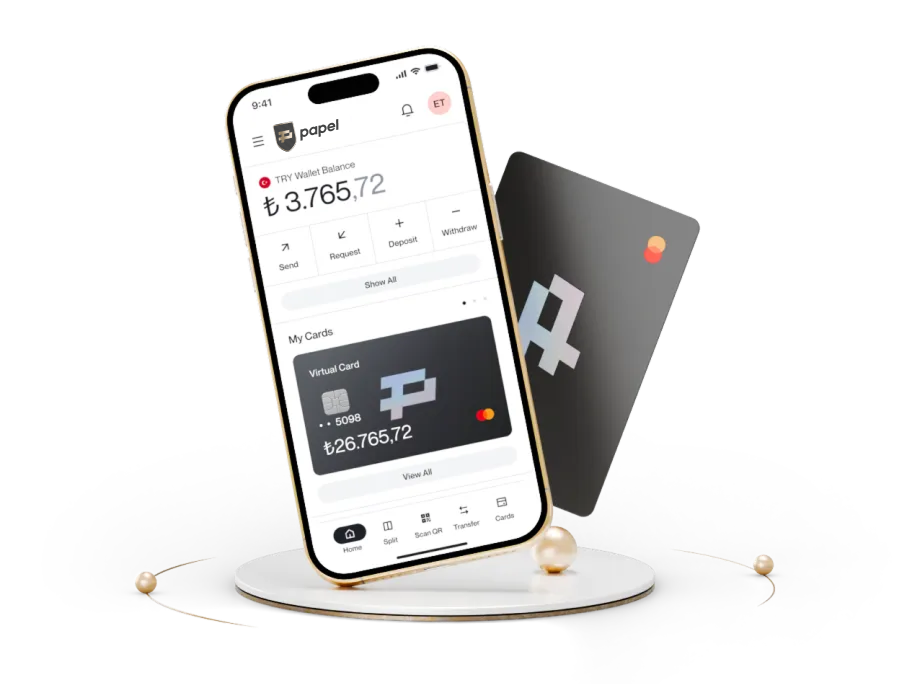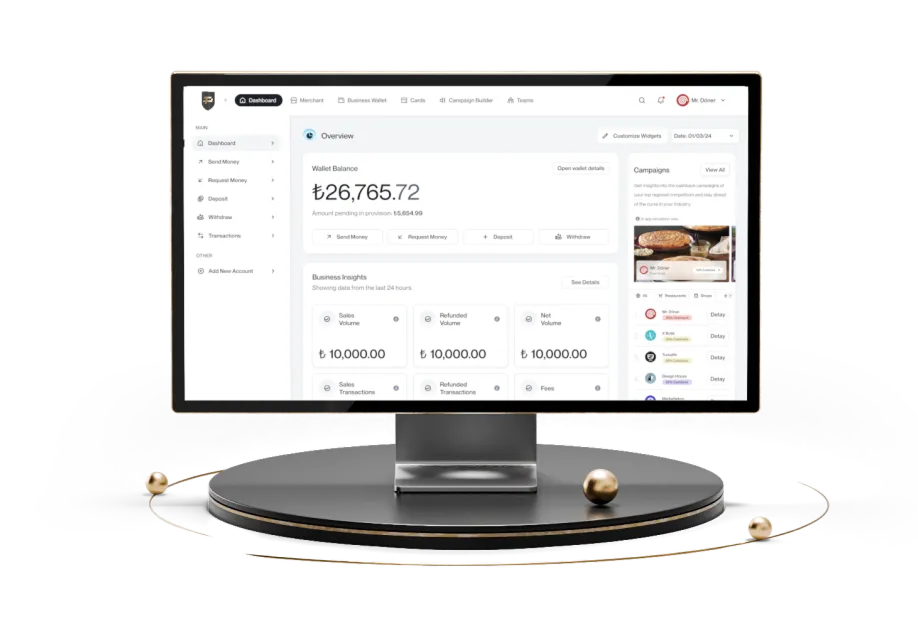One-Click Shopping: A Guide to Mobile Payment
What is Mobile Payment?
Mobile payment is identified as the payment and collection method used by GSM operators under Law No. 6493. However, it is now commonly used as a general term for methods that allow payments to be made with a smartphone or mobile device. The methods and types of mobile payment can vary, and next-generation technologies play an essential role in these types of payments. With mobile payment methods, users can make payments without carrying physical credit/debit cards or cash, which brings advantages such as security, speed, and ease of use.
Advantages of Mobile Payment
Mobile payment offers many advantages to users. Some of these include:
- Convenience
- Speed
- Security
- Expense Tracking
- Eco-Friendly Usage
- Discounts and Promotions
Convenience
Mobile payments simplify the payment experience for both businesses and customers. Payments made via mobile applications using QR codes, NFC, or other technologies are completed efficiently without carrying cards, holding cash, or handling change.
Speed
Just as next-generation technologies have accelerated many areas, mobile payments also speed up the payment experience for users. Payments are completed within seconds. This allows shopping without spending too much time at the checkout, even during busy hours, which benefits businesses and customers.
Security
Various encryption methods are used in mobile payments. Security technologies such as fingerprint and facial recognition on smart devices aim to ensure the safety of customers' payments. Users' data is also encrypted and stored digitally, elevating security to the highest level.
Some applications offer a payment method called “ghost cards. Ghost cards are single-use payment methods. Once the payment is made, the card is deleted from the system, eliminating the possibility of the card information falling into the wrong hands.
Expense Tracking
Purchases made with mobile payment can be reviewed later on the mobile payment application. Since the balance is preloaded when using a digital wallet, tracking expenses becomes easier, helping to prevent budget overruns. Creating prepaid virtual cards makes it easier to manage spending control.
Eco-Friendly Usage
Mobile payment means that all steps related to the payment process can be done digitally. When billing is also included, it prevents paper waste. Storing receipts and invoices digitally instead of receiving them physically helps develop more sustainable and eco-friendly payment habits.
Discounts and Promotions
Many mobile payment applications offer various shopping promotions to increase the use of mobile payments and their applications. These can include discount codes, coupons valid in certain sectors, and special offers available with specific payment methods.
A commonly used campaign mechanism in the fintech sector is cashback. In cashback campaigns, consumers get a certain amount of the money they spend back in cash rather than points. This allows them to spend the balance freely without being limited to specific stores or shops.
How to Make Mobile Payments?
There are many different methods to make mobile payments. Here are the most commonly used ones:
- NFC Contactless Payment
- Banking Applications
- Payment Links and QR Payment
- GSM Operator Payments
- Digital Wallets
NFC Contactless Payment
NFC contactless payments are made using the NFC feature available on a phone or another smart device. After opening the payment application on the smart device, the device is brought close to the merchant's POS terminal to complete the payment. This is a very fast and easy payment method.
Banking Applications
With the rapid development of technology, many banks have been providing banking services through mobile applications. With the fast rise of the fintech sector, these applications are now used as payment methods. Each bank integrates various mobile payment methods into its mobile applications and offers them to its customers.
Payment Links and QR Payments
In payment links, the seller creates a link through the payment service provider's payment system and sends it to the customer. When the customer clicks on the link, a payment screen appears. They complete the payment by entering their card information here. All these transactions can be done via mobile devices and are usually used for remote payments and online shopping.
QR Payments are slightly more straightforward than payment links. The seller generates a unique QR code through their system and sends it to the customer or displays it physically on a POS device in the store. The customer completes the payment by scanning the QR code with their payment application.
GSM Operator Payments
In this method, the amount to be paid is reflected in the customer's GSM phone bill. It can be thought of as using the phone line like a credit card. The single transaction limit for GSM payments is 1,000 TL, and the total limit is 2,750 TL. Mobile payments made within these limits and in-app and SMS purchases are reflected in the bill issued at the end of the month. If the customer uses a prepaid line instead of a postpaid one, they need to preload the balance they wish to spend onto their phone.
Digital Wallets
The banking and fintech sectors have recently focused on this payment method. It allows users to utilize many methods mentioned above in one place. Users can complete their payments using links, QR codes, or NFC.
Digital wallets also offer various features that make life easier, such as cashback, bill payment, and expense sharing. Additionally, deposit, withdrawal, and spending limits can reach banking limits when identity verification is completed. Click here to discover Papel's privileges and create a Papel Wallet.
Step-by-Step Mobile Payment Guide
The steps in mobile payments have been simplified as much as possible to provide businesses and customers with the fastest and easiest experience. However, the steps can vary depending on the payment method used.
In NFC contactless payments, the steps can be as short as “opening the application – bringing the phone close to the POS device – confirmation,” while in link payments, the process may be longer, such as “creating a link – sending the link to the customer – entering card details – 3D Secure confirmation.”
Mobile Payment Security
Mobile payments provide security advantages for both customers and businesses. Customers' digital data is stored in specially encrypted databases, and security measures such as fingerprint and facial recognition are in place during payment. Additionally, users can view every transaction in a digital environment and easily dispute any charges in case of an error.
What Areas Can You Shop in with Mobile Payment?
When considering mobile payments in general, there are no limits on the sectors or categories where customers can make payments. Mobile payment methods can be used in almost every digital market or physical store where credit/debit cards are accepted. However, the areas of use may differ between different mobile payment methods. For example, NFC contactless payments can exclusively be used for physical shopping, while GSM operator payments might have low limits, making it impossible to shop in some categories.
Frequently Asked Questions About Mobile Payment
What is mobile payment? Mobile payment is a general term for technologies that allow payments to be made via a smartphone or other mobile device without the need for cash, a physical bank, or a credit card. It offers customers a fast and easy payment option.
How is mobile payment done? There are many methods for making mobile payments, such as NFC contactless payment, payment links, QR payments, GSM operator payments, banking applications, and digital wallets.
Is mobile payment secure? Mobile payments provide a secure and easy payment experience. Additional security measures such as facial recognition and fingerprint scanning are offered during phone payments. Customer data is encrypted and protected, and transactions can be viewed digitally, allowing for cancellation in case of an error.
What areas can I shop in with mobile payment? Mobile payment methods can be used wherever credit or debit cards are accepted. They can be utilized for online shopping, remote purchases by phone, and physical sales points.
Can I use mobile payment to shop online? Yes, mobile payments can be used for online shopping. Additionally, digital wallet applications may offer campaigns targeted at online shopping.

